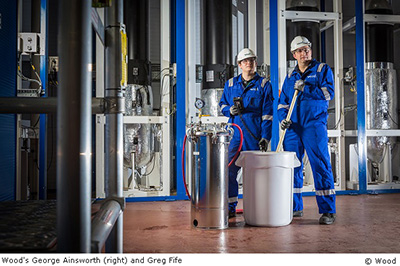 Pipework for the shield cooling system at the Palisades nuclear power plant in Covert, Michigan, is buried in concrete.
Pipework for the shield cooling system at the Palisades nuclear power plant in Covert, Michigan, is buried in concrete.
This means it shares a problem with the UK’s advanced gas-cooled reactors, which have the same design feature. When cooling pipes develop tiny cracks and begin to leak, access is impossible for conventional repair methods such as welding.
That’s why engineers from Wood have been called out three times to Palisades over the past 29 years to apply their own method of sealing the pipes.
The latest visit was part of $87m of work carried out by plant owner and operator Entergy during a two-month refuelling outage which ended on December 28, 2018.
George Ainsworth, a metallurgist who led the Wood team, describes how the leak sealing process works: “We inject a proprietary sealing formulation, consisting of resin and clay, into the pipe run, then pressurise it up to 40 pounds per square inch so that the mixture is forced into any defects responsible for the leakage. Then we flush out the excess, leaving plugs in the defects.
“This sounds very simple, but in reality every defect is different and we have to assess the pipe materials and geometry, the operating environment and the defect size to determine the best sealant formulation and application to use.
“Cracks also develop for different reasons, such as thermal expansion and contraction, stress or corrosion.”
At Palisades, George and colleagues Greg Fife and Joseph Large finished five days ahead of schedule by working simultaneously on most of the eight pipework systems which required attention. And they received a 10-out-of-10 score on every single customer feedback question.
Developed in the 1960s to repair pressure vessel cooling water pipes in the UK, Wood’s leak sealing service has been successfully used worldwide in nuclear power plants, research facilities, nuclear fusion experiments, processing plants, chemical plants, particle accelerators, heat exchangers, water treatment plants and nickel refineries.
Since then, it has been continually developed and improved from the initial concept so that there are now many variations and formulas to deal with a wide range of scenarios. As well as sealing pipes buried in concrete, the technology can be used wherever it is physically impossible to gain access or dangerous to do so because of hazards such as radioactivity, or where the cost of dismantling complex systems is too high.
Even so, Wood’s team is unlikely to return to Palisades because the 811 MW plant is scheduled for permanent retirement in the spring of 2022, 51 years after it first began generating electricity.
Facts about Wood’s leak sealing service
- Seals holes up to 10 millimetres effective diameter
- Highly durable and withstands operating pressures of up to 1,000 pounds per square inch
- Resists corrosive or radioactive environments
- Does not adversely affect pipework
- Tackles pipe runs up to 100 cubic metres in volume
- Successful in a range of operating environments, including highly concentrated nitric acid
- Treats carbon steel, copper, stainless steel and other materials
- Post-treatment flushing ensures that all excess material is removed, eliminating the risk of plugging the pipework
- Performed by fully qualified and experienced teams
- Unintrusive, requires minimal plant modification
- In the unlikely event that the repair is unsuccessful, the process can be repeated
- In collaboration with Wood’s remote operations team, bespoke delivery systems can be developed for localised treatments
Contact
George Ainsworth, Wood
george.ainsworth@woodplc.com
Источник: eurosafe-forum 5.2019
